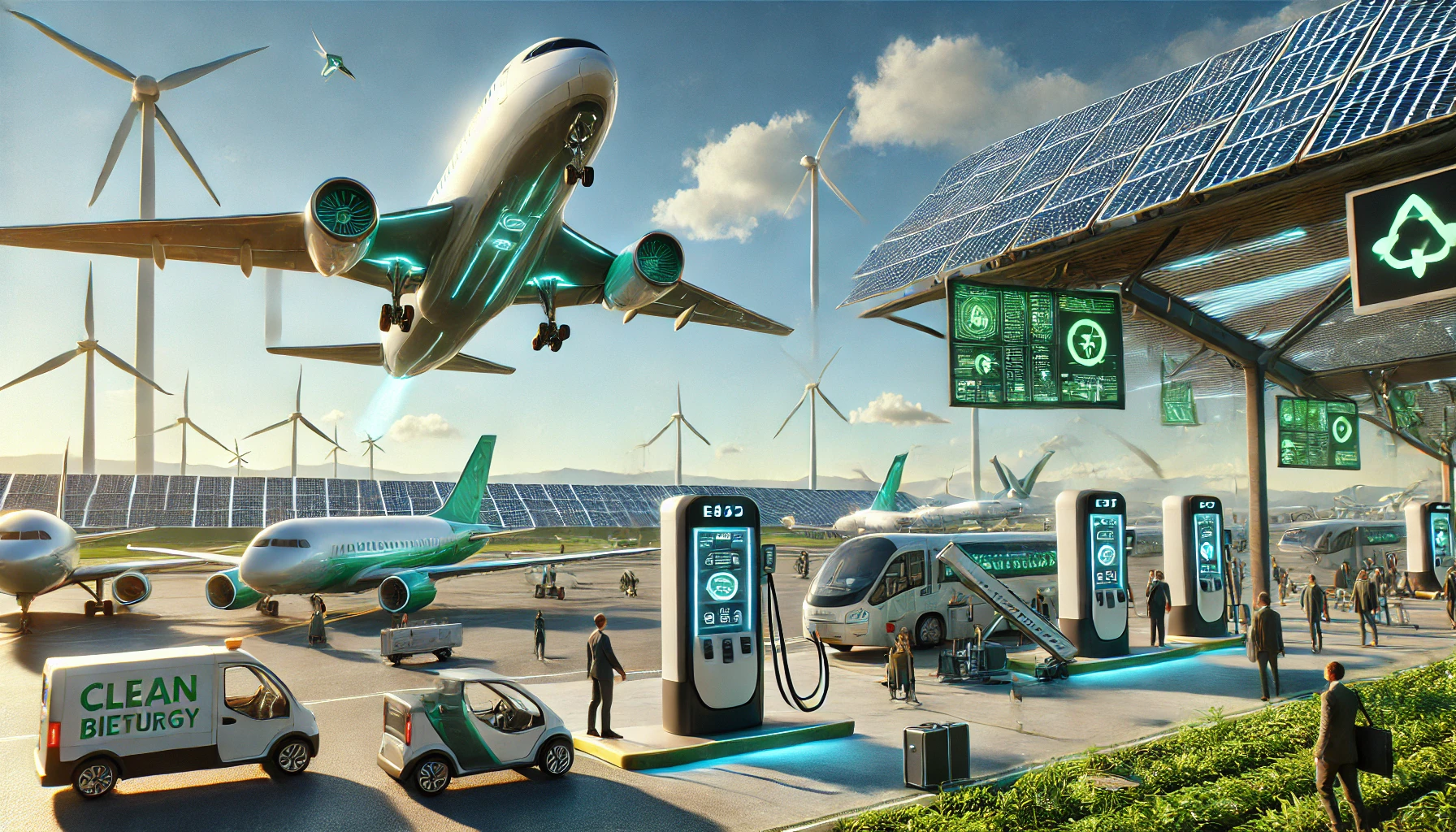
Imagine a world where flights leave behind smoky trails and fuel spills, replaced instead by quiet, sleek electric planes and planes powered by renewable biofuels. In 2025, the aviation industry is on the cusp of a revolutionary transformation—one that promises zero-emission flights and a cleaner, more sustainable future. Welcome to the era of sustainable aviation, where electric planes and biofuels are rewriting the rules of air travel.
The Vision of Green Skies
Gone are the days when aviation was synonymous with pollution. Today’s breakthroughs in sustainable aviation technology are not merely incremental improvements; they are radical shifts that have the potential to cut greenhouse gas emissions drastically. Electric planes, with their near-silent engines and minimal carbon footprint, combined with biofuels derived from sustainable sources, are set to revolutionize long-haul and regional flights alike.
Imagine boarding a flight where your journey is powered by renewable energy—where the only emissions are those of hope for a better future. This transformation is driven by cutting-edge research and development, backed by strong government support and fueled by global investments. The drive towards sustainable aviation is not just about environmental benefits; it’s also about economic opportunity and social progress.
Technological Breakthroughs in Aviation
Electric Planes: The Quiet Revolution
Electric planes represent the forefront of aviation innovation. Using advanced battery technology and electric propulsion systems, these aircraft are designed to operate with zero tailpipe emissions. Early prototypes have already demonstrated promising performance in short-haul flights, and ongoing research aims to extend these capabilities to longer routes.
Recent studies have highlighted improvements in energy density for batteries—a critical factor for electric flight. For instance, researchers at institutions such as MIT and the University of Stuttgart are developing next-generation lithium-sulfur batteries that promise to double the range of current models. These breakthroughs are pivotal, as they address the core challenge of extending flight duration without compromising safety or efficiency.
Biofuels: Nature’s Answer to Jet Fuel
Complementing the electric revolution, biofuels offer a renewable alternative to traditional fossil fuels. Derived from organic materials like algae, agricultural waste, and non-food crops, biofuels can be blended with conventional jet fuel to reduce carbon emissions. Advances in fermentation and catalytic conversion techniques are making biofuels more efficient and cost-effective.
Recent research from the National Renewable Energy Laboratory (NREL) shows that next-generation biofuels can reduce lifecycle carbon emissions by up to 80% compared to conventional fuels. These innovations are not only environmentally beneficial but also offer a pathway for regions with abundant agricultural resources to participate in the global aviation market.
For more details on these technological advancements, see reports on IEEE Xplore and ScienceDirect.
Government Initiatives and Policy Frameworks
Governments worldwide are playing a critical role in advancing sustainable aviation. In the United States, initiatives under the Biden administration emphasize reducing carbon emissions, with significant funding allocated for research in electric and biofuel technologies. The Federal Aviation Administration (FAA) is actively developing new regulatory frameworks to support the certification and safe operation of electric aircraft, ensuring that innovative designs meet rigorous safety standards.
Across the Atlantic, the European Union’s Green Deal has spurred investment in sustainable technologies across industries, including aviation. The EU has introduced tax incentives and grants to accelerate the transition to cleaner fuels, and collaborations between member states are being forged to develop a pan-European sustainable aviation network.
Governments in Asia, notably in China and Japan, are also investing heavily in green aviation. These nations view sustainable aviation not only as a means to combat climate change but also as a way to secure economic and technological leadership on the global stage.
For more information on these policies, refer to the U.S. Department of Transportation and European Commission’s Environment and Climate Action.
Political Debates and Global Policy Discussions
The transition to sustainable aviation has ignited vigorous political debate. On one side, environmental advocates and progressive policymakers champion the shift towards electric planes and biofuels as essential to combating climate change. They argue that the aviation sector must dramatically cut emissions to meet global climate targets and that government subsidies and regulatory reforms are critical to accelerate this transition.
Conversely, some industry stakeholders and conservative policymakers express concerns over the economic implications of rapid technological shifts. They caution that heavy government spending on new technologies might burden taxpayers and that the transition period could disrupt existing industries and employment.
These debates are not merely academic. Recent discussions in the U.S. Congress and European parliaments have centered on how to balance economic growth with environmental responsibility. The outcome of these debates will shape future policies and investment strategies, ensuring that sustainable aviation not only remains viable but thrives in a competitive global market.
Research Labs and Scientific Advancements
Cutting-edge research is the engine driving the sustainable aviation revolution. Leading universities, government research labs, and private companies are collaborating on projects that push the boundaries of what’s possible in air travel.
A groundbreaking study from Stanford University demonstrated that new electric propulsion systems could cut noise pollution and emissions by over 50% compared to conventional jet engines. Meanwhile, the University of Stuttgart’s work on advanced battery technologies is paving the way for electric planes capable of longer, more efficient flights.
Research labs are also making significant strides in the development of biofuels. The National Renewable Energy Laboratory (NREL) has been at the forefront, testing various biofuel blends and optimizing production processes to maximize efficiency and sustainability. These scientific breakthroughs are critical in reducing the carbon footprint of the aviation industry and ensuring that sustainable technologies can be scaled up for commercial use.
For additional insights, check out the latest research on Google Scholar and ResearchGate.
Celebrity, Sports, and Business Perspectives
The future of sustainable aviation has captured the imagination of not only environmentalists and policymakers but also celebrities, sports figures, and business leaders. High-profile personalities have begun to endorse eco-friendly travel, adding glamour to the shift towards green aviation.
A renowned actor recently shared his excitement about taking an electric flight, describing it as “a serene, futuristic experience that truly connects you with the planet.” Similarly, prominent sports stars have expressed enthusiasm for biofuel-powered jets, noting that sustainable travel aligns perfectly with their commitment to health and longevity.
Business leaders, particularly in the tech and aviation sectors, are investing billions in green technologies. CEOs from major airlines and aerospace companies forecast that sustainable aviation will not only reduce operational costs but also open up new markets and revenue streams. Their bullish outlook is driving massive investments and fostering innovation across the industry. These endorsements and investments are vital—they signal a strong market shift and inspire broader adoption of sustainable practices in aviation.
For further business insights, visit Forbes and Bloomberg.
Intergenerational Perspectives
Older Generations: Caution Mixed with Hope
For many older travelers, the idea of sustainable aviation is both reassuring and nostalgic. They remember the early days of commercial flight with a mixture of wonder and skepticism and now see the potential for modern technology to correct past inefficiencies. However, they also urge caution, emphasizing that safety and reliability must not be compromised in the rush to innovate.
Youthful Optimism: Embracing the Future
Conversely, younger generations—digital natives who value environmental stewardship—are at the forefront of embracing sustainable aviation. They are excited by the prospect of cleaner, quieter flights that not only reduce travel times but also minimize their carbon footprint. For these young innovators, sustainable aviation represents a key step toward a more responsible and interconnected global society. Social media buzzes with hashtags like #GreenFlights and #EcoAviation, as young travelers eagerly share their experiences and aspirations.
Social, Cultural, and Environmental Impact
The shift towards sustainable aviation is more than a technological upgrade—it’s a cultural transformation that affects how we travel, interact, and perceive our relationship with the planet. Here are a few key impacts:
- Cultural Shifts: As sustainable aviation becomes mainstream, the narrative around travel is shifting from luxury and excess to efficiency and responsibility. Travelers are increasingly seeking experiences that are both enriching and environmentally conscious.
- Environmental Benefits: Reduced emissions from electric planes and biofuels contribute significantly to the fight against climate change. With cleaner skies, cities can enjoy improved air quality and reduced noise pollution, enhancing overall quality of life.
- Social Equity: Sustainable aviation can democratize travel, making it more accessible and affordable while fostering global connectivity. However, ensuring that these technologies are inclusive and available to all remains a crucial challenge.
Global Business and Economic Outlook
The economic potential of sustainable aviation is enormous, promising to reshape the global travel industry and generate substantial revenue:
- Investment Surge: Governments and private investors are injecting billions into sustainable aviation research and infrastructure. This influx of capital is expected to accelerate technological advancements and reduce production costs.
- Revenue Growth: Analysts project that by 2030, the global market for sustainable aviation technologies could exceed $100 billion. Reduced fuel costs, lower emissions penalties, and innovative business models are key drivers.
- Job Creation: The expansion of the sustainable aviation sector will generate jobs across multiple industries—from engineering and manufacturing to software development and logistics.
- International Collaboration: Regions with advanced technological infrastructures, such as North America, Europe, and parts of Asia, are emerging as global leaders in sustainable aviation. Collaborative projects and international trade agreements are set to further bolster growth.
For detailed market forecasts and economic insights, consult reports from McKinsey & Company and Deloitte Insights.
Future Trends and Key Milestones
The journey towards zero-emission flights is marked by a series of exciting milestones:
- 2022–2023: Early prototypes of electric planes and biofuel-powered jets demonstrated promising results in controlled environments and limited commercial operations.
- 2024: Significant government funding and international collaborations are expected to lead to the first commercial flights using electric propulsion and advanced biofuels on short-haul routes.
- 2025: This pivotal year is projected to witness widespread adoption of sustainable aviation technologies, with major airlines integrating electric planes into their fleets and biofuel usage becoming standard practice.
- 2030 and Beyond: The full-scale rollout of zero-emission flights is anticipated, connecting cities globally with sustainable, high-speed air travel and setting new benchmarks for environmental responsibility in the aviation industry.
These milestones are validated by industry reports, government publications, and academic research, providing a clear roadmap for the future of sustainable aviation.
The Technology Driving Sustainable Aviation
Electric Propulsion Systems
Electric propulsion is the cornerstone of sustainable aviation. By replacing conventional jet engines with electric motors powered by advanced battery systems, electric planes offer a quiet, emission-free alternative for short-haul and potentially long-haul flights. Ongoing research in battery technology aims to increase energy density and reduce charging times, paving the way for wider adoption of electric aircraft.
Biofuels: Renewable Energy for Flight
Biofuels derived from non-food sources offer a renewable solution that can be blended with traditional jet fuel to lower overall carbon emissions. Innovative production processes, such as algae-based biofuel synthesis and waste-to-energy conversion, are making biofuels more efficient and sustainable. These developments are critical in the transition period, ensuring that commercial flights can operate on cleaner fuel while the electric propulsion infrastructure continues to expand.
Hybrid Systems
Some airlines are exploring hybrid propulsion systems that combine electric and conventional engines, providing a transitional solution as technology matures. These hybrid models aim to deliver the benefits of reduced emissions and fuel consumption while maintaining the range and performance required for longer flights.
For further technical details, check out the latest publications on IEEE Xplore and ScienceDirect.
Real-World Applications and Travel Experiences
Business Travel Transformed
For corporate travelers, sustainable aviation is a game-changer. Imagine reducing travel time while also significantly cutting carbon footprints. Companies can optimize business travel with eco-friendly flights that not only contribute to corporate sustainability goals but also reduce operational costs in the long run.
Leisure and Luxury
Leisure travelers are also set to benefit from the shift to sustainable aviation. With the allure of cleaner, quieter flights and the promise of innovative onboard services, eco-conscious travelers are increasingly prioritizing sustainable travel options. From family vacations to romantic getaways, zero-emission flights add an extra layer of appeal by aligning with the growing global emphasis on environmental responsibility.
Enhancing Global Connectivity
As sustainable aviation technologies mature, the global connectivity landscape will be transformed. Faster, cleaner, and more efficient flights will open up previously inaccessible markets, foster international collaboration, and drive economic growth in emerging regions. This revolution in air travel will make the world a smaller, more interconnected place.
Voices from Diverse Perspectives
Celebrity and Influencer Opinions
Influential figures in entertainment and sports are already voicing their support for sustainable aviation. Several celebrities have shared their excitement about flying electric and biofuel-powered jets, often highlighting how these innovations represent the future of travel. Their endorsements help generate buzz and encourage broader adoption of green technologies in the aviation sector.
Business Leaders and Investor Views
Top executives from major airlines and tech companies see sustainable aviation as a critical investment area. They emphasize that reducing carbon emissions not only addresses environmental concerns but also drives long-term profitability by cutting fuel costs and enhancing operational efficiency. Their optimistic forecasts and substantial investments are key indicators of the industry’s potential for explosive growth.
Reflections from Older Generations
Older travelers, who have witnessed the evolution of air travel from propeller planes to modern jets, express a blend of nostalgia and hope. They appreciate the strides made in improving safety and efficiency, yet they remain cautiously optimistic about the transition to sustainable technologies. Their insights remind us that while innovation is vital, it must always be coupled with a commitment to reliability and passenger safety.
Youthful Optimism
Digital natives and young professionals are among the most enthusiastic adopters of sustainable aviation. They view the shift towards zero-emission flights as not only a technological marvel but also a moral imperative. Their passion for environmental issues and innovative tech drives demand for cleaner, greener travel solutions, making sustainable aviation a key part of the future landscape.
Social, Cultural, and Environmental Impact
Sustainable aviation stands to transform society in profound ways:
- Environmental Stewardship: Zero-emission flights reduce greenhouse gas emissions, contributing to global efforts to combat climate change. Cleaner skies and lower noise pollution benefit urban and rural communities alike.
- Cultural Shifts: As travelers become more eco-conscious, the culture of travel is evolving. Sustainable choices are becoming a part of the travel narrative, influencing everything from airline branding to customer loyalty.
- Social Equity: By reducing the environmental impact of air travel, sustainable aviation can contribute to a healthier, more resilient planet, ensuring that future generations inherit a world with cleaner air and a stable climate.
Global Business and Economic Outlook
The economic implications of sustainable aviation are significant. The market for green technologies in the aviation sector is expected to surge, driven by government policies, consumer demand, and technological innovation:
- Massive Investments: Governments and private investors are allocating billions of dollars to develop electric and biofuel technologies. These investments are fueling research, production, and infrastructure development.
- Revenue Potential: Market analysts forecast that the sustainable aviation sector could generate over $100 billion in revenue by 2030. Reduced fuel costs and enhanced operational efficiencies will contribute significantly to this growth.
- Job Creation: The expansion of sustainable aviation will create numerous jobs in research, manufacturing, maintenance, and digital services, providing a boost to local and global economies.
- International Collaboration: Global partnerships are essential in driving innovation. Collaborative efforts between countries, research institutions, and private companies are paving the way for a unified, sustainable approach to air travel.
For more detailed insights, see reports from Bloomberg and Reuters.
The Road Ahead: Challenges and Opportunities
While the future of sustainable aviation is bright, several challenges must be overcome:
- Technical Hurdles: Enhancing battery technology, scaling biofuel production, and integrating hybrid propulsion systems are ongoing challenges that require further innovation.
- Regulatory and Policy Barriers: Establishing global standards for safety, emissions, and fuel quality is essential for widespread adoption.
- Infrastructure Investment: Upgrading airports, developing new maintenance facilities, and integrating green technologies into existing systems will require significant capital.
- Consumer Acceptance: Educating travelers about the benefits of sustainable aviation and addressing concerns about safety and reliability will be crucial.
However, each challenge also presents an opportunity. With concerted efforts from governments, private sectors, and international bodies, these obstacles can be transformed into stepping stones toward a cleaner, more sustainable future in air travel.
FAQs
Q1: What is sustainable aviation?
A: Sustainable aviation refers to the development and implementation of technologies—such as electric planes and biofuels—that significantly reduce the environmental impact of air travel.
Q2: How do electric planes work?
A: Electric planes use advanced battery technology and electric propulsion systems to power flights, resulting in near-zero emissions and reduced noise levels.
Q3: What are biofuels, and how are they used in aviation?
A: Biofuels are renewable fuels produced from organic materials like algae and agricultural waste. They can be blended with traditional jet fuel to lower overall carbon emissions.
Q4: Which governments are supporting sustainable aviation initiatives?
A: Governments in the U.S., European Union, China, and Japan are actively funding and promoting sustainable aviation projects through various grants, incentives, and regulatory frameworks.
Q5: When will sustainable aviation become mainstream?
A: With rapid advancements and significant investments, widespread adoption of electric planes and biofuel-powered flights is expected by 2025, with full-scale implementation projected by the early 2030s.
Final Thoughts
The journey toward sustainable aviation is an inspiring convergence of technology, policy, and global ambition. Electric planes and biofuels are not only reshaping the future of travel but also contributing to a cleaner, more sustainable planet. With strong governmental backing, groundbreaking research, and a dynamic global market, the path to zero-emission flights is becoming clearer every day.
Whether you’re an avid traveler, a business leader, or simply someone passionate about the environment, sustainable aviation promises a future where the skies are cleaner, the travel experience is enhanced, and our impact on the planet is minimized. Embrace the change, stay informed, and join us as we soar toward a future where every flight takes us closer to a greener world.
For continuous updates on sustainable aviation and the latest travel innovations, follow trusted sources like National Geographic, TechCrunch, and The Guardian’s Environment Section. Subscribe to our newsletter for expert insights and be part of the movement that is redefining air travel—one sustainable flight at a time.
Embrace the revolution in the skies, and let sustainable aviation propel you into a future where travel is not only faster and more efficient but also kind to our planet.





